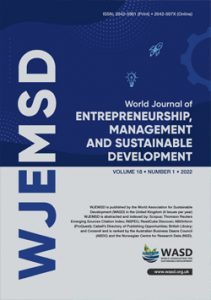Entrepreneurial activity in the Albertine Graben region of Uganda: the role of infrastructure development and entrepreneurial orientation, Muhammed Ngoma, Peter Ntale and Mwesigye Castro
 Muhammed Ngoma
Muhammed Ngoma
Faculty of Graduate Studies and Research
Makerere University Business School, Kampala
Uganda
Peter Dithan Ntale
Directorate of Doctoral Training, Faculty of Graduate Studies and Research
Makerere University Business School, Kampala
Uganda
Email: pntale@mubs.ac.ug
Mwesigye Castro
Institute of Petroleum Studies Kampala, Kampala
Uganda
DOI: 10.1108/WJEMSD-04-2020-0028
Purpose: The purpose of this paper is twofold (1) to establish the relationship between infrastructure development and entrepreneurial orientation (EO) on the entrepreneurial activities in the Albertine Graben region of Uganda and (2) to establish whether entrepreneurial orientation mediates the relationship between infrastructure development and entrepreneurial activity.
Design/methodology/approach: Quantitative data were collected from a sample of 118 enterprises, mainly small businesses. The authors sent out 118 self-administered questionnaires of which 93 useable questionnaires were returned, giving a response rate of 79%. Quantitative data were processed and analyzed using SPSS version 21. Analyses such as correlation, hierarchical regression and mediation were carried out to understand (1) the relationship between the variables, (2) the prediction potential of the independent variables to entrepreneurial activity and (3) the mediation role of EO on the relationship between infrastructure activity and business performance.
Findings: The authors found out that infrastructure developments are a significant predictor of entrepreneurial activity (ß = 0.432**, p < 0.01), explaining 21.6% of entrepreneurial activity in the region. EO was found to have a significant positive relationship with entrepreneurial activity (r = 0.580**, p < 0.01). The results of a hierarchical regression indicate that both infrastructure development and EO explain 42% of the entrepreneurial activity in the Albertine region. Mediation analysis indicated that EO is a partial mediator in the relationship between infrastructure development and entrepreneurial activity.
Research limitations/implications: The results are based on self-report statistics. The model explains 42% of entrepreneurial activity thus there is need to examine the influence of other factors which contribute the 58% to entrepreneurial activity. The study was also limited to public infrastructure, with much attention on transportation (roads) and energy (electricity). Future studies can consider looking at private infrastructure as well.
Practical implications: Understanding the role of infrastructure development and EO helps government and other development partners to know the type, quantity and quality of the infrastructure required as well as how to grow the EO of entrepreneurs to boost entrepreneurial activity in the region.
Originality/value: This paper provides insights into our understanding of the relationship between infrastructure development, entrepreneurial orientation and entrepreneurial activity using evidence from Uganda’s oil rich region. The originality of this paper further lies in the discovery of the partial mediation of entrepreneurial orientation in the relationship between infrastructure development and entrepreneurial activity. This is the first time such a study is conducted in an African developing country such as Uganda whose oil exploration activities are still in their infancy.
Keywords: Infrastructure development; Entrepreneurial orientation; Entrepreneurial activity; Albertine Graben; Uganda.
Citation: Ngoma, M., Ntale, P.D. and Castro, M. (2021), "Entrepreneurial activity in the Albertine Graben region of Uganda: the role of infrastructure development and entrepreneurial orientation", World Journal of Entrepreneurship, Management and Sustainable Development, Vol. 17 No. 3, pp. 601-615. https://doi.org/10.1108/WJEMSD-04-2020-0028

